
Artemisia Gentileschi. Self Portrait as the Allegory of Painting (La Pittura), c1638-9 (detail). Oil on canvas, 98.6 × 75.2 cm. Royal Collection Trust / HM The Queen (405551). Royal Collection Trust / © Her Majesty Queen Elizabeth II 2019.
National Gallery, London
3 October 2020 – 24 January 2021
by ANNA McNAY
The Italian Baroque painter Artemisia Gentileschi (1593-c1656) is well on her way to becoming as widely recognised an artistic icon as Frida Kahlo. Certainly in the era of #MeToo, her autobiography of being raped by a fellow artist, a friend of her father, at the age of 17, and enduring a seven-month-long trial, which included torture, to test the veracity of her testament, goes before her and makes her name – for better or worse – more well-known than her artwork. Of the latter, those paintings depicting biblical heroines as strong – and often vengefully violent – real women are the most beloved, and, in fact, generally the only ones known. I confess to having been oblivious to many of her more tender subjects until this long-overdue – and latterly delayed due to Covid-19 closures – exhibition at the National Gallery, London, finally opened its doors.
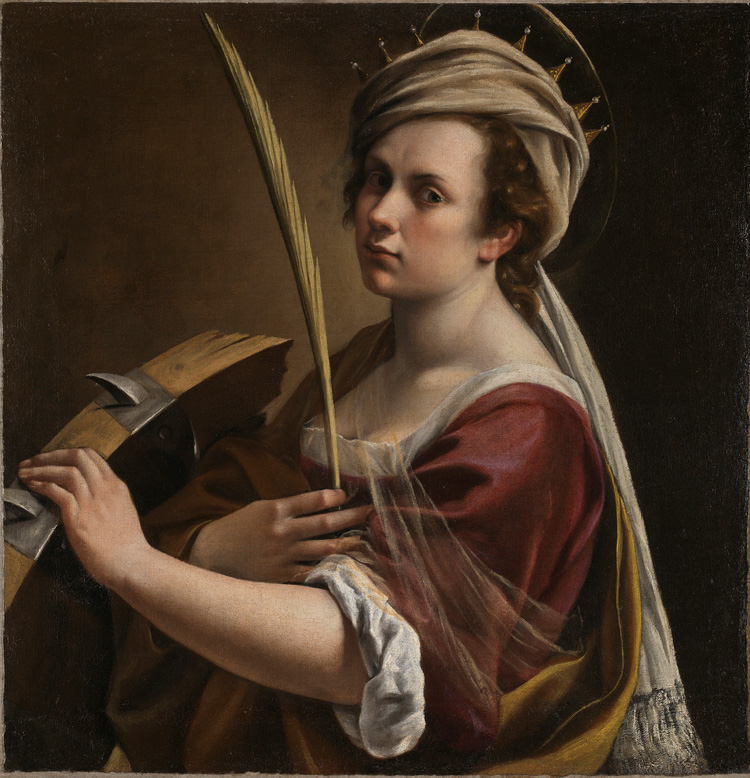
Artemisia Gentileschi. Self Portrait as Saint Catherine of Alexandria, c1615-17. Oil on canvas, 71.4 × 69 cm. © The National Gallery, London.
The catalyst for the exhibition was the acquisition by the gallery, in 2018, of Gentileschi’s Self-Portrait as Saint Catherine of Alexandria (c1615-17), the first painting by the artist to enter a UK public collection. Not only did the work undergo extensive restoration, documented in detail on the gallery’s YouTube channel, but it then went on a nationwide tour, visiting the most unlikely venues, including a doctor’s surgery, a school and a women’s prison. While this helped to generate publicity and momentum for this first exhibition of Gentileschi’s paintings in Britain, within the art world, the cogs had already been turning for a couple of decades, with major exhibitions in Rome, New York and Saint Louis (2001-02), Milan (2011-12) and Paris (2012-13). Alongside these showcases, increased research and interest has also uncovered a number of previously unknown works, as well as treasure troves of letters and other archival material. Gentileschi’s art – and more predominantly her life – have further been taken as inspiration for numerous novels, films, documentaries and musical and theatrical productions.
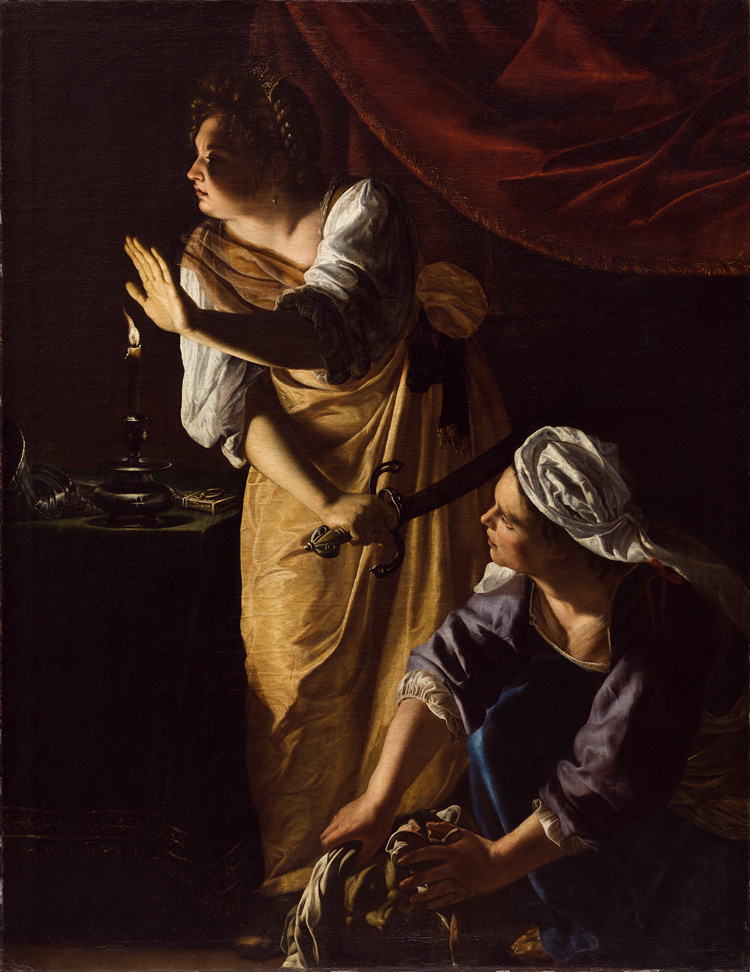
Artemisia Gentileschi. Judith and her Maidservant, c1623-5. Oil on canvas, 184 × 141.6 cm. The Detroit Institute of Arts, Gift of Mr. Leslie H. Green (52.253). © The Detroit Institute of Arts.
This much-awaited exhibition, then, is finally an opportunity to let Gentileschi speak for herself, through her work. It has been carefully and selectively curated – comprising 30 works (which, in itself, was no mean feat to assemble) – to tell a neatly topped-and-tailed story of her 40-year career, beginning and ending with a return to the same subject matter; to provide occasion to look at Gentileschi’s stylistic progression and to compare and contrast her work with that of her father (to whom her paintings have often erroneously been attributed). It also offers an overview of her journey through numerous cities, working for some of the most prestigious 17th-century patrons, and leading the way as a woman making a living (just about) as an artist, at a time when this was still very much the exception.
Gentileschi was born in Rome on 8 July 1593, the eldest child and only daughter of the painter Orazio Gentileschi (1563–1639). Following the death of her mother, when she was 12, she became a substitute mother for her three brothers. She was permitted to train alongside them, under her father, but, owing to her sex, was confined largely at home – something she later described as “noxious”. There she would have been able to copy her father’s drawings and paintings, as well as work from engravings, which were cheap and easily available. Her father’s influence is evident in Gentileschi’s early pictures, but even from the outset, her own voice and interpretations ring through.
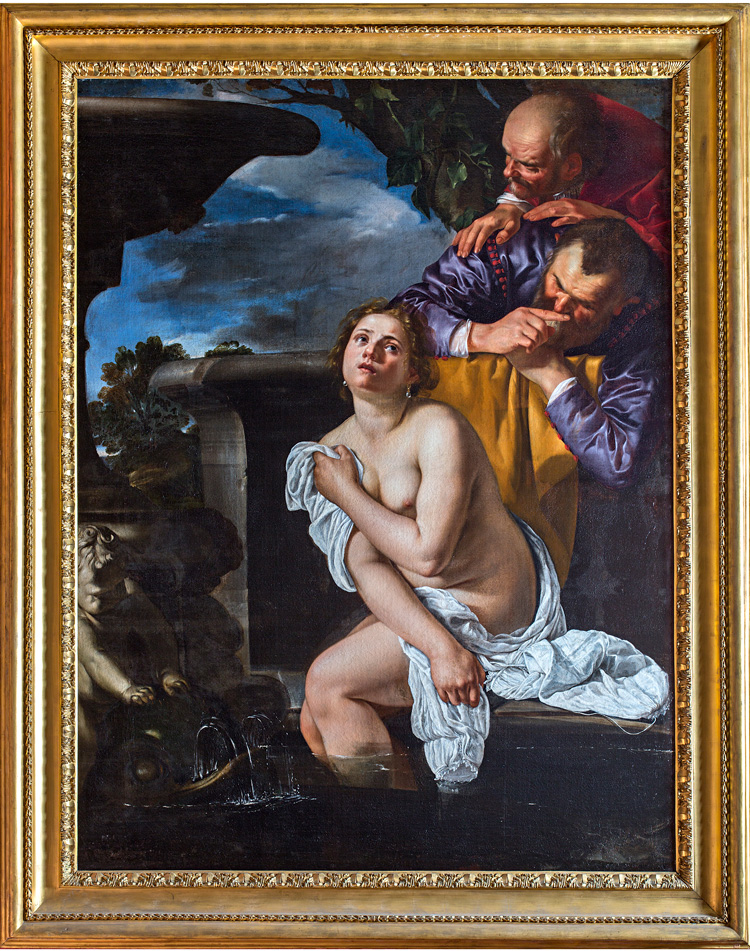
Artemisia Gentileschi. Susannah and the Elders, 1622. Oil on canvas, 161.5 × 123 cm. © The Burghley House Collection.
The exhibition opens with the earliest work signed and dated by Gentileschi: Susannah and the Elders (1610), painted when she was just 17. The story of Susannah, as told in the Apocrypha, has come to be closely associated with the artist – alongside that of Judith. Wife of Joachim, the beautiful young woman is surprised by two elders while bathing in a fountain in her garden. They demand her submission and threaten to accuse her of adultery if she refuses them. Nevertheless, she resists their advances, only to be faced with a false accusation and threat of death. In her many versions of the story, Gentileschi typically depicts the dramatic moment in which Susannah is pounced on. She portrays it from a feminine perspective, focusing very much on the plight of the protagonist. In this early rendering, in particular, there is a shuddering viscerality to Susannah’s anguished frown, flushed cheeks and the contorted twist of her body as she seeks to protect herself from the two men looming above her in oppressive proximity. The detailed depictions of the creases of her flesh, the bones of her fingers and the translucent shadows of her veins make her all the more human; vulnerable and exposed beneath the cloaked men.
It was a few months after painting this picture, in May 1611, that Gentileschi was raped by the painter Agostino Tassi (c1580-1644). Although Tassi was ultimately condemned and banished, this punishment was never enforced. Instead, a day after the trial closed, Gentileschi was married off to the Florentine painter Pierantonio di Vincenzo Stiattesi, whose elder brother had prepared her father’s legal defence, and they left Rome for Florence. The trial, infamous at the time and now, was documented through a detailed transcript, and this, too, is included in the exhibition.
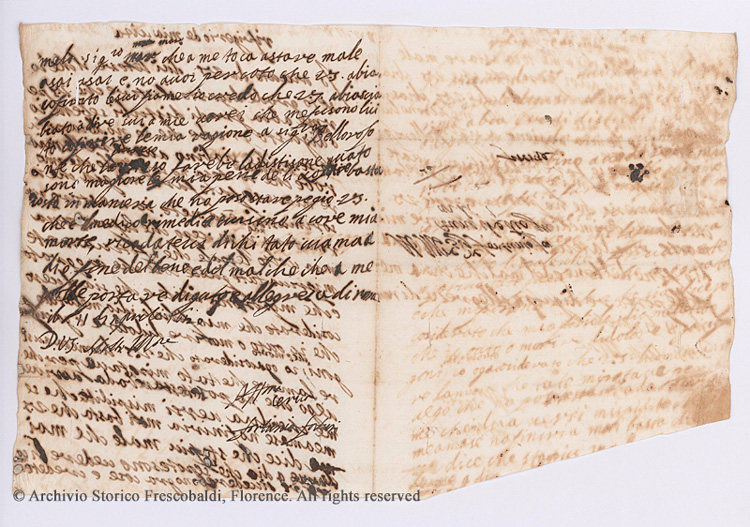
Solinas 2011, Letter 20, Artemisia to Francesco Maria Maringhi. Rome, 11 April 1620. Paper. Archivio Storico Frescobaldi, Florence. © Photo courtesy of the owner.
Leaving Rome for Florence gave Gentileschi the chance to escape her father’s shadow. She also made herself known to the ruling Medici family – great patrons of the arts – and, in 1616, became the first woman to become a member of the Accademia delle Arti del Disegno. This affiliation identified her as a professional painter. Privately, however, her marriage was not a happy one, with Stiattesi running up myriad debts. She bore five children in five years, with only two surviving infancy. In 1618, she embarked on a passionate affair with Francesco Maria Maringhi, attested here by letters in her own hand – with her autodidactic phonetic spelling and grammatical errors – on loan from the Archivio Storico Frescobaldi, Florence, where they have been since their discovery in 2011. The letters offer a fresh insight into Gentileschi’s personality, and are, like her paintings, intimate, with a sense of humour, passion and vulnerability. In one, she asks Maringhi not to masturbate in front of her painting. There is, however, also the suggestion that Gentileschi and Stiattesi were complicit in exploiting Maringhi financially, and, indeed, she ultimately fled Florence, pursued by Grand Duke Cosimo II’s fury, having failed to complete a number of paintings for him (a felony equal to theft).
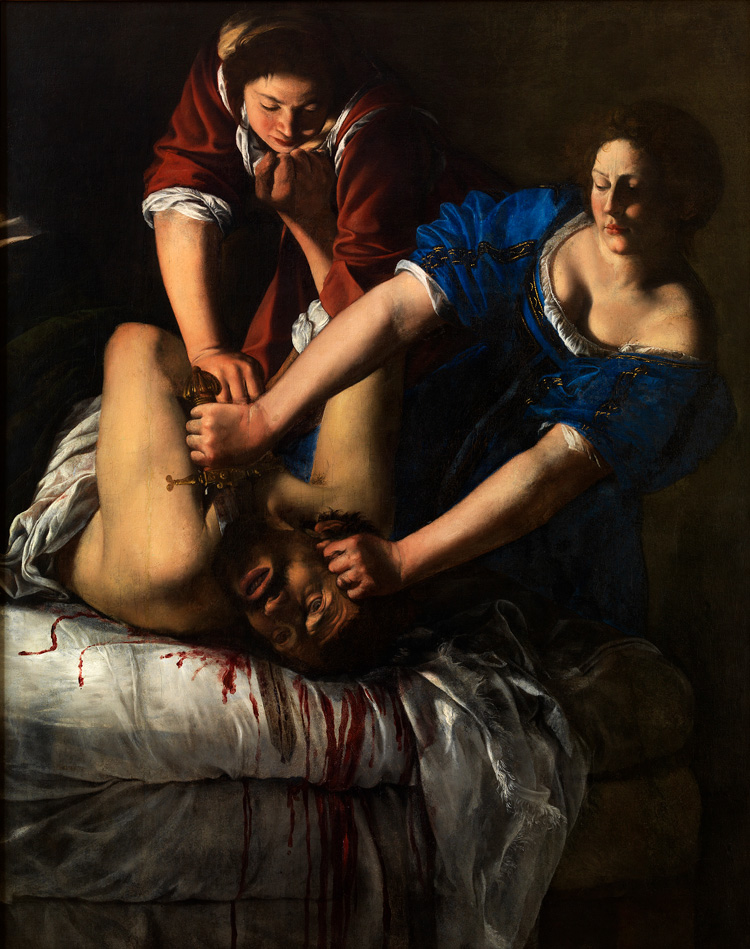
Artemisia Gentileschi. Judith beheading Holofernes, c1612-13. Oil on canvas, 158.8 × 125.5 cm. Napoli, Museo e Real Bosco di Capodimonte (Q378). © ph. Luciano Romano / Museo e Real Bosco di Capodimonte 2016.
While autobiography is again wont to overtake artwork, the room focusing on these Florentine years has two key components: two of Gentileschi’s paintings of Judith beheading Holofernes (1612-13 and 1613-14) and four self-portraits. Again stemming from the Apocrypha, the story of Judith tells how she saved the city of Bethulia from the Assyrians by beheading their general, Holofernes. Shown side by side for the first time, these two breathtaking renderings have frequently been read as Gentileschi taking revenge in paint for her own experience. While the first of the two paintings is certainly striking, it is the second, now housed in the Uffizi, Florence, where everything truly comes together. Judith, dressed in yellow, with her maid in a pale blue, wrestles with her simultaneous grip on the sword and Holofernes’ head, undeterred by the spray of blood, which mingles with and is magnified by the red velvet draped over his groin. The triangular composition of the three bodies, and the use of primary colours, now emphasises Judith and Holofernes far more than the earlier work, where the two women are dominant. The sense of struggle is more fervent; the Caravaggesque light all the more enhanced.
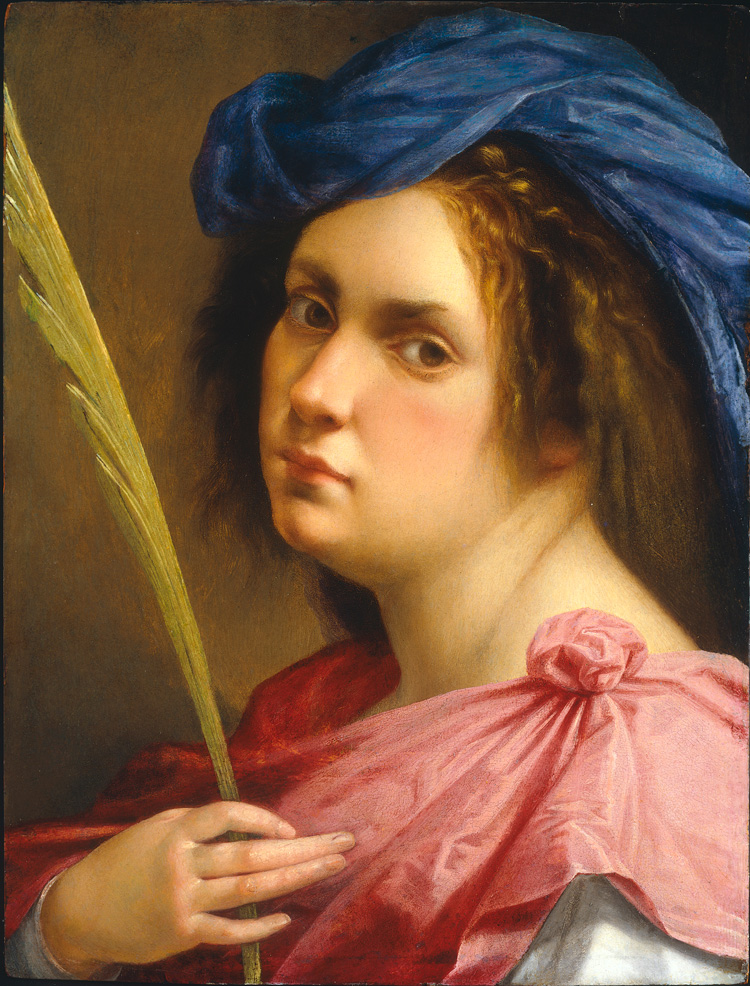
Artemisia Gentileschi. Self Portrait as a Female Martyr, c1613-14. Oil on panel, 31.8 × 21.8 cm. Private collection. © Photo courtesy of the owner.
The self-portraits, too, are an interesting component of Gentileschi’s oeuvre. While there were, of course, practical reasons for using herself as a model – it being both cheaper and easier – the artist was also clearly versed in the skills of self-promotion. In 1649, for example, she wrote to the Sicilian nobleman and collector Antonio Ruffo: “If Your Lordship likes my work, I will also send you my portrait, so that you may keep it in your gallery as all the other Princes do.”1 As the exhibition curator, Letizia Treves, writes: “Her words reveal a clear stratagem.” Nevertheless, Treves further flags up that any discussion about Gentileschi’s portrayal of herself in her paintings needs to distinguish – which it rarely does – between “self-portraiture”, in the sense of a literal recording of features, and “self-representation”, where a resemblance is clear, but the artist takes on different guises. Further of note is the fact that the term “self-portrait” was not yet in usage in Gentileschi’s day. It is nevertheless worthwhile considering the guises in which she does choose to portray herself – as an anonymous female martyr and as the fourth-century martyr Saint Catherine of Alexandria, who survived torture on a wheel studded with iron spikes, only to be beheaded later. Once again, should one wish to look through the lens of autobiography (as one frequently has), there is much that might be inferred.
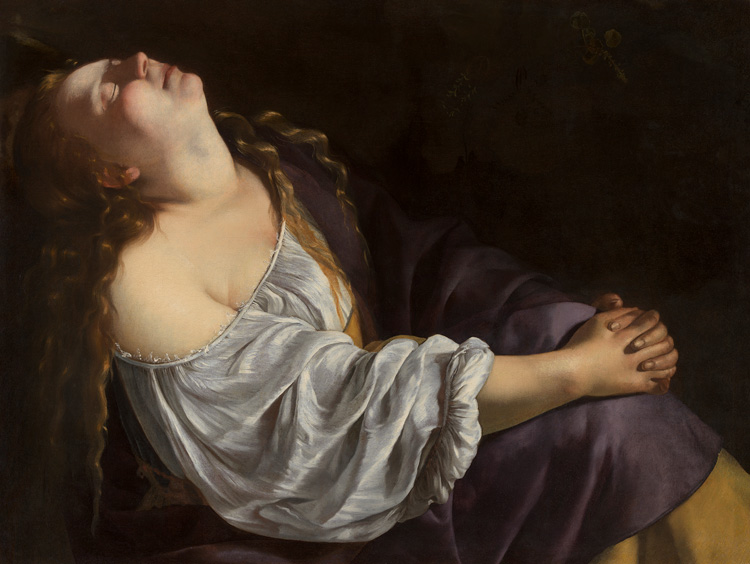
Artemisia Gentileschi. Mary Magdalene in Ecstasy, c1620-25. Oil on canvas, 80 × 106 cm. Private European collection. © Photo: Dominique Provost Art Photography - Bruges.
Further female “heroines” to appear throughout the exhibition include Cleopatra, Danaë, Lucretia and a fabulous, recently discovered painting of Mary Magdalene in Ecstasy (c1620-25), showing the saint as neither penitent nor suffering, but passionate and in the explicit throes of rapture. As mentioned, however, there are further, more surprising, works also on display, including the tender Madonna and Child (c1613-14), where Mary’s eyes are shut, as she squeezes her breast towards her infant, who gently reaches out and strokes his mother’s face. Once more, it could be argued that only a woman could have painted in this manner – but it is certainly a different vision of woman than the revenge-seeking victim of rape normally associated with Gentileschi. In works like this, we see the artist in the role of mother.
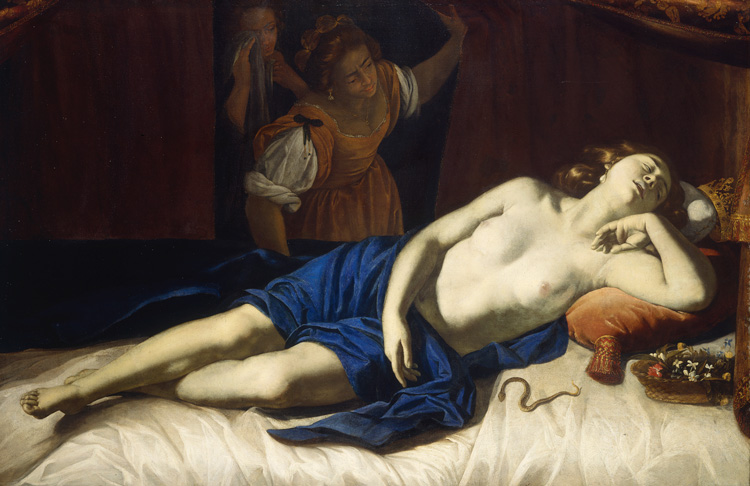
Artemisia Gentileschi. Cleopatra, c1633-5. Oil on canvas, 117 × 175.5 cm. Private collection. © Private Collection / Photo Giorgio Benni.
The largely chronological exhibition follows Gentileschi from Florence back to Rome, thence to Venice and on to Naples (then under Spanish rule), where, excepting a brief, two-year interlude in London, she settled for the final 25 years of her life (despite vehemently disliking it), and where she established a thriving studio, which she ran together with her daughter Prudenza, also a painter. We now see her repertoire expand to include literary and allegorical paintings – one as part of a cycle painted for Philip IV of Spain, adapted to suit the style at hand – as well as altarpieces and works made in collaboration with other leading Neapolitan artists.
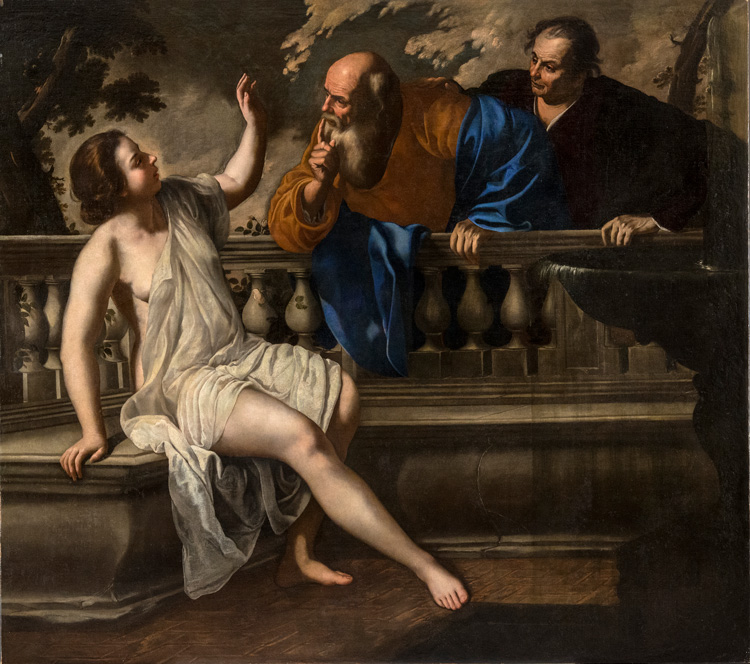
Artemisia Gentileschi. Susanna and the Elders, 1652. Oil on canvas, 200.3 × 225.6 cm. Polo Museale dell’Emilia Romagna, Collezioni della Pinacoteca Nazionale, Bologna. © Pinacoteca Nazionale Bologna (6320).
Before the epilogue, comes the bookend: Gentileschi’s final known work, which returns to the subject of her earliest paintings – Susannah and the Elders (1652). Here we see just how much her style has developed (although this work was arguably also a collaboration). In comparison to the earlier picture, this seems far more stylised and less full of the fear, repulsion and energy that pervaded the previous canvas. The response is more psychological than visceral, and the protagonist is depicted as less vulnerable, protecting her modesty with a white drape. Had Gentileschi mellowed with age? Had she finally worked through her own trauma and rage? Or was she simply painting for a patron and meeting his taste? Some art historians have referred to Gentileschi as a chameleon, because of her ever-changing style, but Treves sees this adaptability as a skill, and perhaps the key to the artist’s enduring success in so many different cities and for so many different patrons.
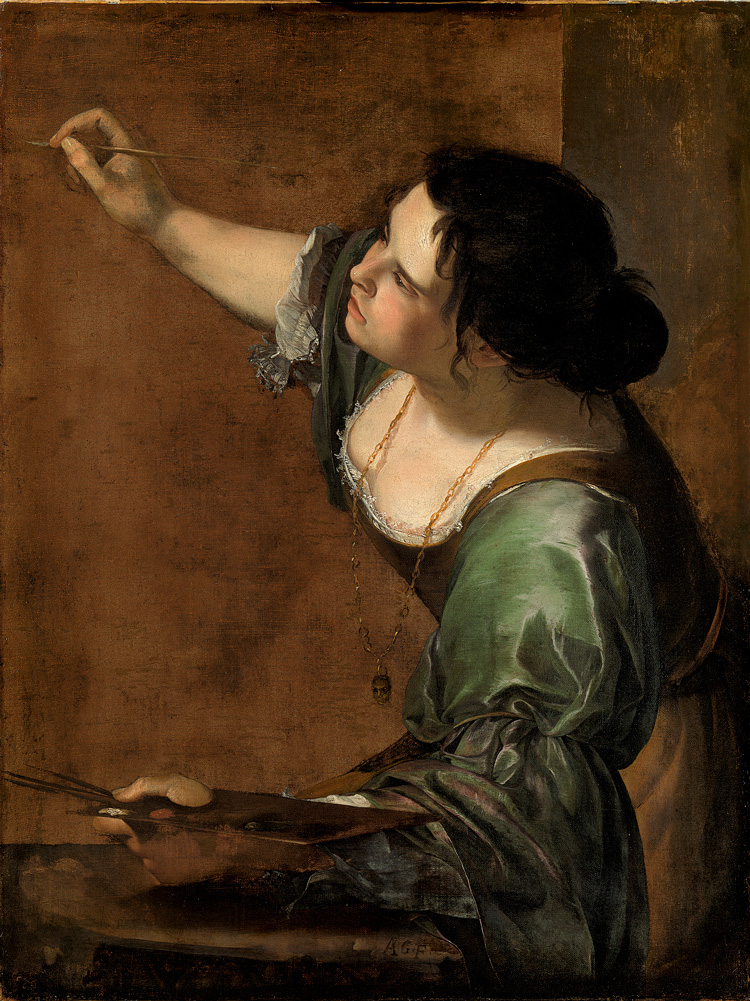
Artemisia Gentileschi. Self Portrait as the Allegory of Painting (La Pittura), c1638-9. Oil on canvas, 98.6 × 75.2 cm. Royal Collection Trust / HM The Queen (405551). Royal Collection Trust / © Her Majesty Queen Elizabeth II 2019.
The final room – the epilogue – follows Gentileschi to London, where she travelled in 1638, purportedly to assist her ailing father in painting the canvases for the ceiling of the Queen’s House in Greenwich (now kept at Marlborough House). The final work on display is one of the only pictures known to date from these London years – Self-Portrait as the Allegory of Painting (La Pittura) (c1638-39) – which is a self-representation in the guise of painting, depicting the activity as something energetic, purposeful and physical, not in the slightest contemplative. It speaks, pictorially, of what Gentileschi’s life and art meant to her, perhaps equally captured in her words, so echoic of Elizabeth I’s: “With me Your Lordship will not lose and you will find the spirit of Caesar in the soul of a woman.”2
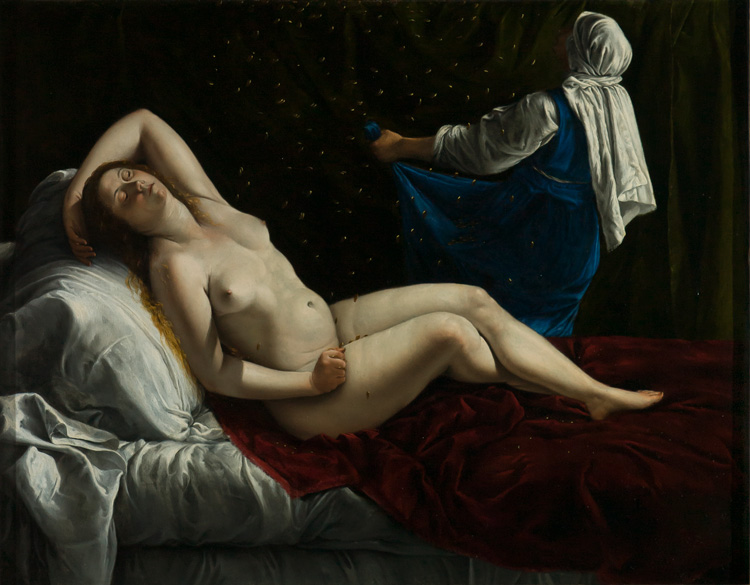
Artemisia Gentileschi. Danaë, c1612. Oil on copper, 41.3 × 52.7 cm. Saint Louis Art Museum. Museum Purchase 93:1986. © Saint Louis Art Museum.
It is not known exactly when Gentileschi died, although it is thought likely to have been during the Naples plague of 1656. During her lifetime, she was regarded as one of the most accomplished painters, with her works being collected by the leading rulers of the day, including Cosimo II de’ Medici in Florence, Philip IV in Madrid, and Charles I in London. Typically, for a woman artist, she then fell out of the canon, and has only really begun to be re-evaluated in the 20th and 21st centuries. Alongside this physical exhibition, the National Gallery team has worked hard, during the five-month delay occasioned by the pandemic, to produce a lot of extra material to share via the gallery website and its social media channels. This includes a film retracing Gentileschi’s footsteps through Rome, Florence, Naples and London, and some very short films, responding to specific works, by the singer/songwriter FKA Twigs, which will doubtless accelerate Artemisia’s aforementioned Frida-effect. The Google Arts & Culture team has also created a digital accompaniment to the exhibition, allowing viewers to zoom in on the paintings and read relevant stories and information. There are even augmented reality offerings (I will stay silent on what I think about this one!), bringing Gentileschi’s paintings into 3D virtual life in your own home. Gabriele Finaldi, the director of the National Gallery, describes the exhibition as “a tribute to the resilience of Artemisia”, noting that she is a lesson to us all in these difficult times. It seems she might be a lesson to us all for all time – but, regardless of all she survived, her true legacy deserves to be her painting, not her life story. Look closely and you might just find it equally as inspiring.
References
1. Artemisia portraying herself by Letizia Treves. In Artemisia, exhibition catalogue, National Gallery, London, 2020, page 64.
2. Letter from Artemisia Gentileschi to Don Antonio Ruffo, 13 November 1649.